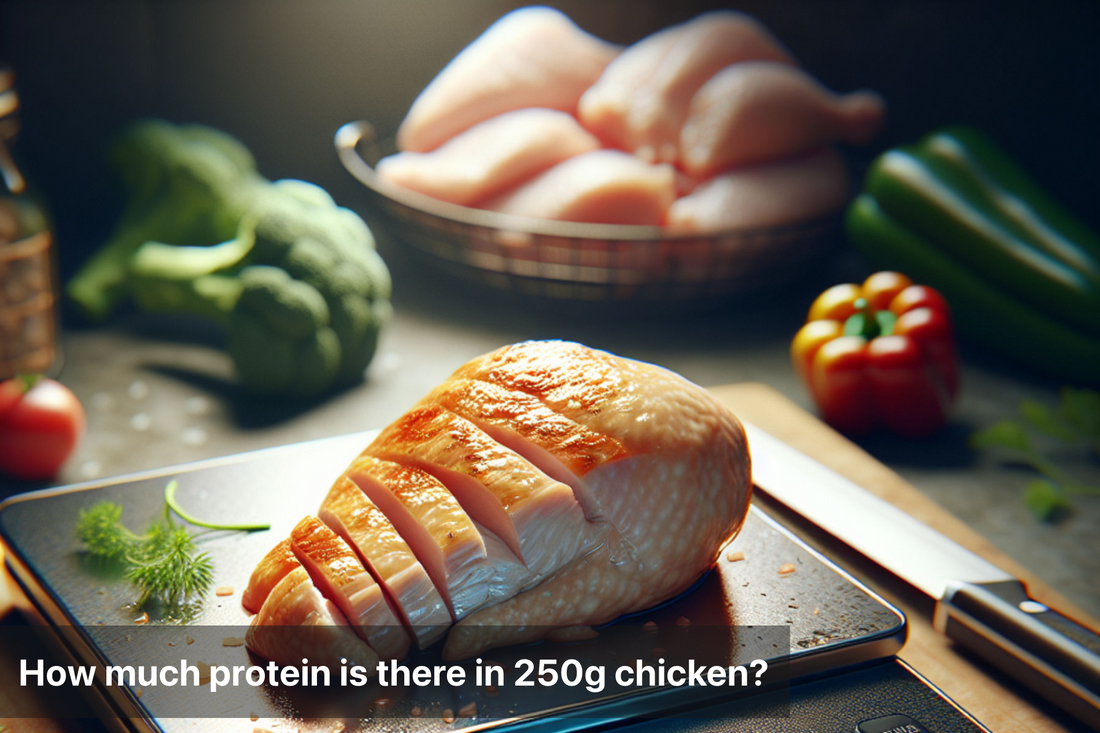
How much protein is there in 250g chicken?
Share
Chicken is one of the most consumed sources of lean animal protein worldwide. Whether grilled, boiled, roasted, or curried, it’s a staple in many Indian diets for those looking to build muscle, maintain weight, or simply get adequate nutrition. If you're tracking your protein intake, one of the most common questions is—how much protein is there in 250g chicken? The answer depends on the cut, whether it's raw or cooked, and how it's prepared.
Protein Content in 250g Chicken
In general, 250 grams of raw, skinless chicken breast contains approximately 62–65 grams of protein. This value slightly reduces after cooking due to water loss, but the total protein remains the same—just more concentrated by weight.
Chicken Form |
Quantity |
Protein Content |
|---|---|---|
Raw chicken breast |
250g |
~62–65g protein |
Cooked chicken breast |
~180g |
~62–65g protein |
Raw chicken thigh |
250g |
~45–48g protein |
Cooked chicken thigh |
~180g |
~45–48g protein |
Cooking shrinks the portion due to moisture loss, but it doesn’t reduce the protein content. Instead, the protein per gram increases.
Macronutrient Breakdown (250g Raw Chicken Breast)
Nutrient |
Value |
|---|---|
Calories |
~412 kcal |
Protein |
~62 g |
Fat |
~9 g |
Carbohydrates |
0 g |
Fiber |
0 g |
Sugar |
0 g |
Chicken is a pure protein and fat source, making it ideal for low-carb, high-protein diets.
Chicken Breast vs Thigh: Protein Comparison
Chicken breast is the leanest cut, while thighs are more flavorful and slightly higher in fat. Here's a quick comparison for 250g:
Cut |
Protein |
Fat |
Calories |
|---|---|---|---|
Chicken Breast |
62g |
9g |
412 kcal |
Chicken Thigh |
46g |
18g |
440 kcal |
Choose breast if you're focused on high protein and low fat. Thighs are better for taste and higher calorie meals.
How Cooking Affects Protein Count
While cooking chicken doesn’t reduce the total amount of protein, it does reduce the overall weight due to water loss. For example, 250g raw chicken breast shrinks to about 180g cooked, but the protein content remains close to 62g. Grilling or baking retains more nutrients, while deep-frying adds unnecessary fat.
Health Benefits of Chicken Protein
1. Muscle Building
Chicken is a complete protein, containing all nine essential amino acids. It supports muscle growth, recovery, and lean mass maintenance.
2. Weight Management
High-protein foods like chicken increase satiety and thermogenesis, helping control appetite and boost metabolism.
3. Immunity and Healing
Protein is essential for antibody production, cell repair, and immune function. Chicken also contains zinc and selenium, important for immunity.
4. Blood Sugar Control
When paired with carbohydrates, chicken helps stabilize blood glucose levels, making it a smart choice for diabetics.
5. Bone Health
Though not high in calcium, chicken protein plays a role in maintaining bone density and reducing age-related muscle loss.
How to Include 250g Chicken in a Balanced Diet
Grilled or pan-seared with herbs and lemon for a lean, high-protein meal
Shredded and added to salads or soups for a filling lunch
Stir-fried with vegetables and minimal oil for a balanced dinner
Boiled and shredded for wraps, sandwiches, or meal prep boxes
Cooked with dal or millet for a protein-carb combo
Common Dishes Using 250g Chicken (Calorie Estimates)
Dish |
Protein |
Calories |
|---|---|---|
Grilled Chicken (plain) |
~62g |
~400 kcal |
Chicken Curry (homemade) |
~55g |
~500 kcal |
~45g |
~600 kcal |
|
Chicken Salad |
~60g |
~450 kcal |
Chicken Wrap (with roti) |
~40g |
~480 kcal |
Note: Calories vary based on oil, masala, and other added ingredients.
Who Should Eat 250g Chicken Daily?
Gym-goers and athletes aiming for muscle mass and strength
Weight watchers who want high protein and low carb
People recovering from illness needing tissue repair
Individuals on low-carb, paleo, or keto diets
Anyone struggling to meet daily protein goals
For most adults, 250g chicken provides over 80–90% of their daily protein needs, depending on activity level.
Can You Eat 250g Chicken Every Day?
Yes, for healthy adults, daily consumption of 250g chicken is safe and beneficial. However, it’s important to balance it with:
Adequate fiber from vegetables or whole grains
Hydration for kidney support during high protein intake
Variety—include fish, eggs, and plant proteins too for diverse nutrition
If you have kidney disease or specific dietary restrictions, consult a nutritionist before consuming high-protein diets.
Summary
250 grams of raw chicken breast contains around 62–65 grams of high-quality protein, making it one of the most efficient animal protein sources for muscle building, recovery, and overall health. It’s low in carbs, moderate in fat, and highly versatile in Indian and global cuisines. Whether grilled, curried, or pan-fried with vegetables, chicken fits seamlessly into a well-balanced diet. For fitness goals or protein tracking, 250g chicken can serve as your core lean protein source—just remember to prepare it wisely and eat it as part of a whole, nutrient-rich meal.






